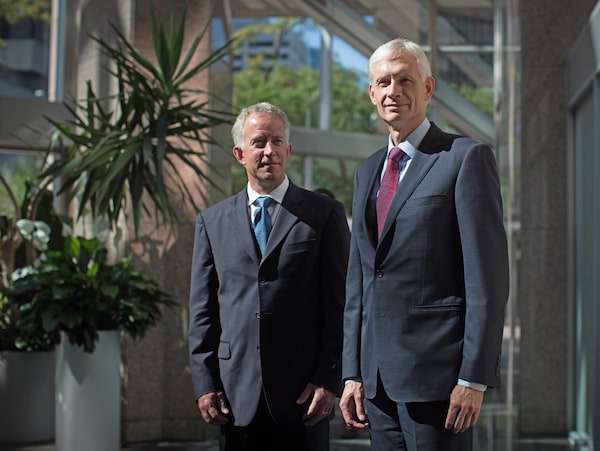
Shell Canada President Michael Crothers, right, and Petronas Energy Canada President & CEO Mark Fitzgerald.DARRYL DYCK/The Globe and Mail
Two of Canada’s top energy executives are backing the federal government’s plan to use a section in the Paris climate accord that would allow Canada to gain emission credits for exporting liquefied natural gas to Asia.
Shell Canada Ltd. president Michael Crothers and Petronas Energy Canada Ltd. president Mark Fitzgerald are trying to fend off criticisms from environmentalists, who say exporting LNG isn’t the answer to transitioning to a low-carbon economy. The parent companies are the two leading co-owners in LNG Canada, which began building an $18-billion export terminal last year in Kitimat, B.C.
Shell and Petronas stand to benefit from Ottawa’s plan to gain emission credits as energy companies strive to align their corporate goals with the Paris accord.
The two Canadian executives say LNG is a cleaner energy source for power plants than coal, which is widely used in Asia to generate electricity. They say that once LNG Canada starts to export natural gas in liquid form by early 2025, it would help decrease air pollution from coal-fired power plants in countries such as China.
“Shell sees the potential for bilateral arrangements under the Paris accord to allow credit to be given for the low-carbon intensity exports of gas from Canada to places in Asia,” Mr. Crothers said.
Under the 2015 Paris agreement to which Ottawa is a signatory, a section called Article 6 could clear the way for bilateral side deals that would mean Canada gains credits toward meeting its targets for decreasing carbon emissions.
Marc Lee, senior economist with the B.C. office of the Canadian Centre for Policy Alternatives, said that in many instances, LNG could displace renewable energy in China.
LNG Canada’s co-owners “want to make their project look in as favourable light as possible because they know people are concerned about climate-change impacts, so they’re framing it as something that’s going to reduce global emissions,” Mr. Lee said.
But Mr. Crothers and Mr. Fitzgerald, who are both based in Calgary, said during interviews while visiting Vancouver that long-term demand for LNG in Asia is strong and it’s best to take a global perspective on greenhouse gas (GHG) emissions.
“Emissions reduction has to be considered in the global context. I wish methane emissions and carbon dioxide stopped at the borders, but they don’t," Mr. Fitzgerald said. “Energy demand is not going to go away. Article 6 is one mechanism that allows us to treat this truly as a global opportunity."
Shell Canada’s parent, Royal Dutch Shell PLC, is the largest partner in LNG Canada, with a 40-per-cent stake. The other partners are Petronas Energy Canada’s parent, Malaysia’s state-owned Petronas (25 per cent), PetroChina (15 per cent), Japan’s Mitsubishi Corp. (15 per cent) and South Korea’s Kogas (5 per cent).
“China itself has made commitments to reduce its emissions. You can see that one of our partners in our LNG project is a Chinese company," Mr. Crothers said.
Environment and Climate Change Minister Catherine McKenna and Natural Resources Minister Amarjeet Sohi have expressed their support for emissions trading. Mr. Sohi told The Globe and Mail in May that Ottawa views Article 6 as an opportunity for Canada to reach bilateral pacts with countries buying LNG such as China and Japan.
Isabelle Turcotte, director of federal policy at clean-energy think tank Pembina Institute, said she is taking a wait-and-see attitude until learning details from the next Conference of the Parties (COP) to be held in December in Chile, where Article 6 will be a major point of discussion.
“We’re looking forward to the next COP with much anticipation," Ms. Turcotte said. “We’ll be paying attention to how these negotiations evolve and culminate to give us a set of rules that really make sure that we’re not trading hot air."
Details for Article 6 are slated to be worked out in Chile, including the framework of internationally transferred mitigation outcomes (ITMOs), which involve voluntary co-operation arrangements between two countries.
Jason Dion, lead researcher at Canada’s Ecofiscal Commission, an economics think tank, is skeptical about whether Ottawa will be able to easily tap into Article 6 and avoid double-counting of emission reductions. "Someone is going to have to pay to turn these low-carbon exports into ITMOs,” Mr. Dion said. “If the federal government intended to subsidize the consumption of LNG abroad, then that would make Canadian LNG more competitive internationally and China maybe would be willing to give up ITMOs if the fuel came in at a subsidized rate.”
He said that it’s in the interest of LNG companies to cast their product as part of the solution to global climate change.
Since British Columbia has its own carbon tax and provincial policy dealing with GHG emissions, LNG Canada isn’t subject to the federal government’s carbon-pricing regime introduced this year against large emitters in five provinces: Ontario, Manitoba, New Brunswick, Prince Edward Island and Saskatchewan (partial application), as well as two territories – Yukon and Nunavut.
The Shell-led project is aiming for 0.15 carbon-dioxide equivalent tonnes for each tonne of LNG produced, which is a level below British Columbia’s limit for “emissions intensity” of 0.16 CO2 equivalent tonnes.
LNG Canada estimates project-related costs will total $40-billion for the first phase, counting the $18-billion Kitimat terminal and various infrastructure that includes TransCanada Corp.’s $6.2-billion Coastal GasLink pipeline, which will run 670 kilometres from northeast British Columbia to Kitimat. The total budget also includes billions of dollars a year to be spent by producers drilling for natural gas in northeast B.C.
While Coastal GasLink has been approved by all 20 elected First Nation councils along the planned route, the pipeline project has been the target of protests led by a group of eight Wet’suwet’en Nation hereditary chiefs. The chiefs have cited climate change among the reasons for their opposition to Coastal GasLink.
 Brent Jang
Brent Jang